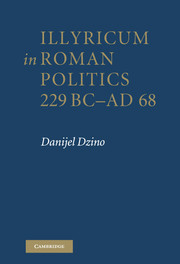Book contents
- Frontmatter
- Contents
- List of figures
- List of maps
- List of tables
- Acknowledgments
- Timeline
- 1 Introduction, approaches, review of sources and secondary literature
- 2 Illyricum in Roman foreign affairs: historical outline, theoretical approaches and geography
- 3 Roman trans-Adriatic engagement (229–168 BC)
- 4 Rome across the Adriatic in the late Republic (167–59 BC)
- 5 The construction of Illyricum: Caesar in Illyricum and the Civil Wars (59–44 BC)
- 6 Octavian in Illyricum
- 7 From senatorial to imperial Illyricum: Bellum Pannonicum
- 8 The failure of Greater Illyricum: the Bellum Batonianum
- 9 Iulio-Claudians in Illyricum: the tale of two provinces
- Conclusion: the construction of Illyricum in Roman political discourse
- Bibliography
- Index
1 - Introduction, approaches, review of sources and secondary literature
Published online by Cambridge University Press: 05 May 2010
- Frontmatter
- Contents
- List of figures
- List of maps
- List of tables
- Acknowledgments
- Timeline
- 1 Introduction, approaches, review of sources and secondary literature
- 2 Illyricum in Roman foreign affairs: historical outline, theoretical approaches and geography
- 3 Roman trans-Adriatic engagement (229–168 BC)
- 4 Rome across the Adriatic in the late Republic (167–59 BC)
- 5 The construction of Illyricum: Caesar in Illyricum and the Civil Wars (59–44 BC)
- 6 Octavian in Illyricum
- 7 From senatorial to imperial Illyricum: Bellum Pannonicum
- 8 The failure of Greater Illyricum: the Bellum Batonianum
- 9 Iulio-Claudians in Illyricum: the tale of two provinces
- Conclusion: the construction of Illyricum in Roman political discourse
- Bibliography
- Index
Summary
ROME AND THE WESTERN PART OF THE BALKAN PENINSULA
The conquest of Illyricum has been examined previously in the context of a general narrative of Roman expansion, as has initial Roman interaction with Illyricum from the perspective of Dalmatian or Pannonian provincial history, and through the analysis of primary sources. This book will examine Roman political conduct in Illyricum, the development of Illyricum in Roman political discourse and the beginning of the process that would integrate Illyricum into the empire and wider networks of the Mediterranean world. It will reveal Roman political and military engagement through the ways in which Roman power was present in Illyricum across the Adriatic and from Aquileia via the Ocra pass between 229 BC, when Roman involvement across the Adriatic starts, and the later Iulio-Claudian era, when permanent control over the Danube is established. In addition, this book will try to explore, as much as it is possible, the different narratives of this process, apart from the Romanocentric narrative of power and Roman military conquest, which dominate the available sources, and earlier scholarly interpretation of the events.
It is highly doubtful that the Romans could organise a grand strategy, apart from the loosely defined idea of the ‘conquest of the world’. We cannot really talk about ‘foreign policy’ in the modern sense, which implies a level of intentionality and consistency of planning during long periods of time. However, the Roman strategy on a regional level appears much clearer and better defined.
- Type
- Chapter
- Information
- Illyricum in Roman Politics, 229 BC–AD 68 , pp. 1 - 17Publisher: Cambridge University PressPrint publication year: 2010



